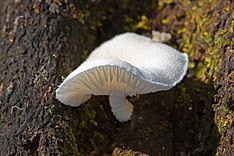tr
kırıntılardaki isimler


Oudemansiella australis is a species of gilled mushroom in the family Physalacriaceae. It is found in Australasia, where it grows on rotting wood. It produces fruit bodies that are white, with caps up to 5.5 cm (2.2 in) in diameter, attached to short, thick stems.
The species was reported as new to science by Greta Stevenson and G.M. Taylor in a 1964 publication, based on a specimen found in March, 1961.[1] According to the 1986 arrangement of Pegler and Young, based largely on spore structure, Oudemansiella australis is classified in the section Oudemansiella of genus Oudemansiella, along with the species O. mucida, O. venesolamellata, and O. canarii.[2] In a more recent classification proposed by Yang and colleagues, O. australis is in section Oudemansiella, which contains tropical to south temperate species, such as O. platensis, O. canarii and O. crassifolia. These species are characterised by having an ixotrichoderm cap cuticle, meaning it is made of gelatinized filamentous hyphae of different lengths arranged in roughly parallel fashion. These hyphae are often mixed with inflated cells that usually occur in chains.[3]
New Zealand mycologist Geoff Ridley has proposed the common name "porcelain slimecap" for the mushroom.[4]
Oudemansiella australis mushrooms have a cap that is 3–5.5 cm (1.2–2.2 in) in diameter, and initially white becoming a light yellowish brown (fawn) in age. It has a convex shape, but splits at the margins. The cap cuticle splits irregularly to reveal firm white flesh underneath. The gills are adnate, powdery white, and moderately distantly spaced. They are long and short intercalated, with deep with ribs at the base. The stem is 2.5 cm (1.0 in) long by 0.6–1 cm (0.2–0.4 in) thick, attached off-centre to the cap. It is white on the upper part, changing to fawn around the swollen base. The flesh is solid, white, and silky.[1]
The spore print is white. Spores are spherical or nearly so, measuring 24 by 21 µm, with thick walls (about 1 µm). They are non-amyloid, and have a prominent hilar appendix (a depression in the surface where the spore was once connected to the sterigmata).[1][2]
The fungus grows on rotting wood. The first recorded collection was made in the open near a forest in Wainui Valley, Wellington.[1] It has since been found in Australia and Papua New Guinea.[5]
Oudemansiella australis is a species of gilled mushroom in the family Physalacriaceae. It is found in Australasia, where it grows on rotting wood. It produces fruit bodies that are white, with caps up to 5.5 cm (2.2 in) in diameter, attached to short, thick stems.
Oudemansiella australis je grzib[1], co go ôpisoł G. Stev. & G.M. Taylor 1964. Oudemansiella australis nŏleży do zorty Oudemansiella i familije Physalacriaceae.[2][3] Żŏdne podgatōnki niy sōm wymianowane we Catalogue of Life.[2]
Oudemansiella australis je grzib, co go ôpisoł G. Stev. & G.M. Taylor 1964. Oudemansiella australis nŏleży do zorty Oudemansiella i familije Physalacriaceae. Żŏdne podgatōnki niy sōm wymianowane we Catalogue of Life.

澳洲小奥德蘑(學名:Oudemansiella australis),俗稱陶瓷泥蓋(porcelain slimecap),是一種擔子菌門真菌,隸屬於奥德蘑屬(英语:Oudemansiella)。這種真菌廣泛地分佈在大洋洲,並且主要在腐木上生長。呈白色,菌蓋直徑約為5.5厘米(2.2英寸),而菌柄則短而粗。
澳洲小奥德蘑最早是由新西蘭真菌學家格里塔·史蒂文森(英语:Greta Stevenson)和G·M·泰勒於1964年描述的。[1]他們是根據於1961年採集得來的標本來為這種真菌命名。[2]於1986年,澳大利亞真菌學家佩格勒和安東尼·M·楊根據其孢子結構,將這種真菌和黏小奧德蘑等數種真菌歸類為一個新的屬,即奥德蘑屬。 [3]其學名中的「australis」源自拉丁文,意思是「南方」,即「澳洲」。[4]而這種真菌的俗稱,「陶瓷泥蓋」,則是由新西蘭真菌學家傑夫·里德利提出。[5]
澳洲小奥德蘑的菌蓋直徑為3–5.5厘米(1.2–2.2英寸),呈白色,但隨著年齡增加會變成淺土黃色。呈凸面狀及偏移狀,但其邊緣會翹起。[6]其翹起的菌蓋導致其白色的菌肉露了出來。其菌柄高約2.5厘米(1英寸),厚0.6–1厘米(0.2–0.4英寸),頂端呈白色,底部呈淺土黃色,且菌柄與菌蓋的連接位偏離菌蓋中央。[7]其菌褶呈白色,它們之間的間距適中,且子實層是連生的。其菌肉呈白色,堅固,且質感柔滑。[2]其孢子印呈白色,而其近乎球體的擔孢子的大小則為24 x 21微米,並且有著厚近1微米的孢子壁。[2][3]
澳洲小奥德蘑廣泛地分佈在大洋洲,其中包括澳洲、新西蘭和巴布亞新幾內亞。[8]這種真菌通常在樹林中出現,且通常是在腐木上生長。這種真菌的第一個標本是在惠靈頓懷努谷中收集得來的。[9]
澳洲小奥德蘑的可食性仍然存疑。部份文獻指出這種真菌並不可供食用[10],而部份文獻則指出包括這種真菌在內的所有奥德蘑屬真菌均可供食用。[11]
澳洲小奥德蘑(學名:Oudemansiella australis),俗稱陶瓷泥蓋(porcelain slimecap),是一種擔子菌門真菌,隸屬於奥德蘑屬(英语:Oudemansiella)。這種真菌廣泛地分佈在大洋洲,並且主要在腐木上生長。呈白色,菌蓋直徑約為5.5厘米(2.2英寸),而菌柄則短而粗。